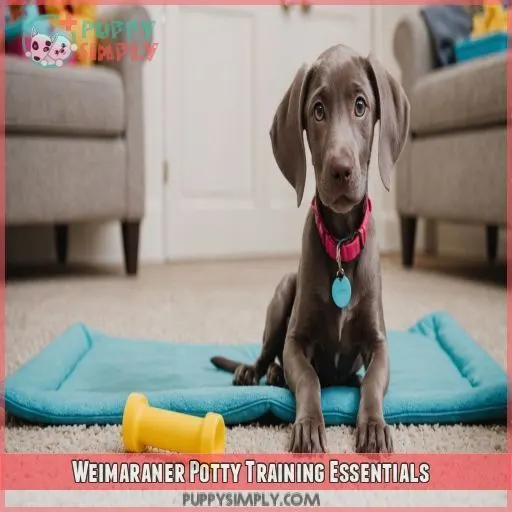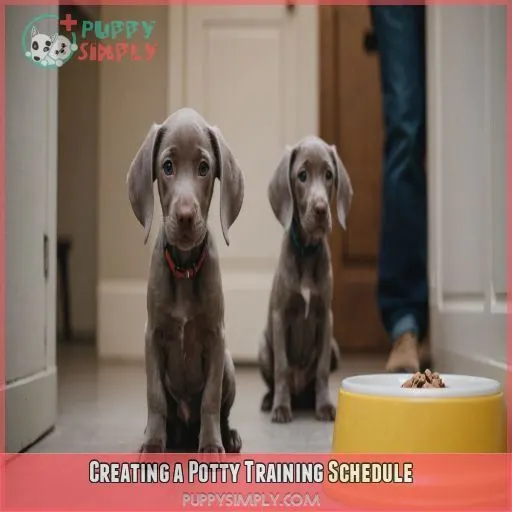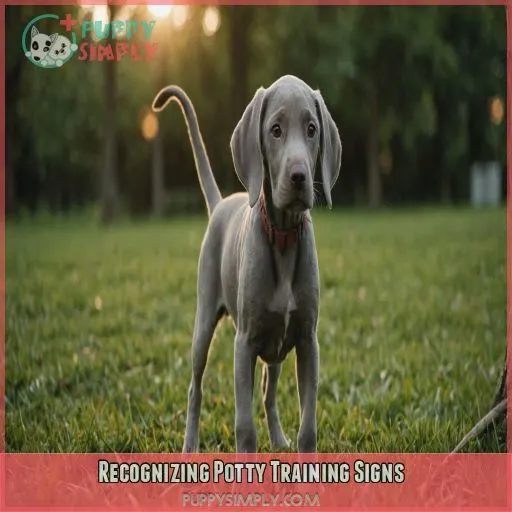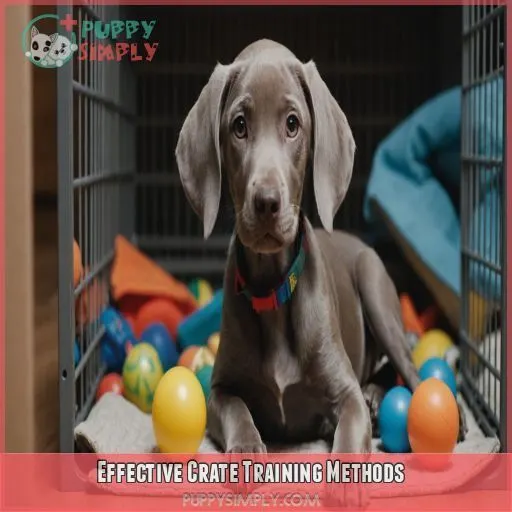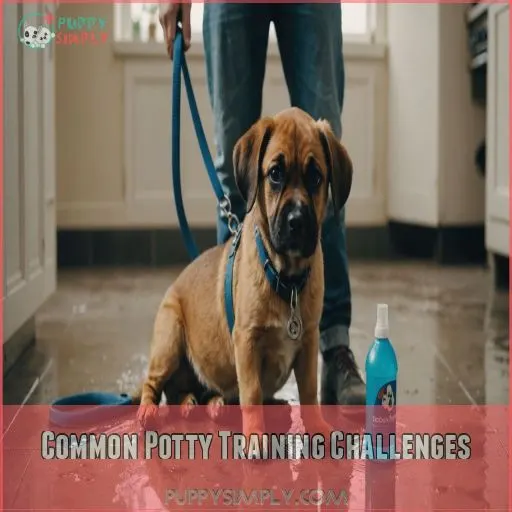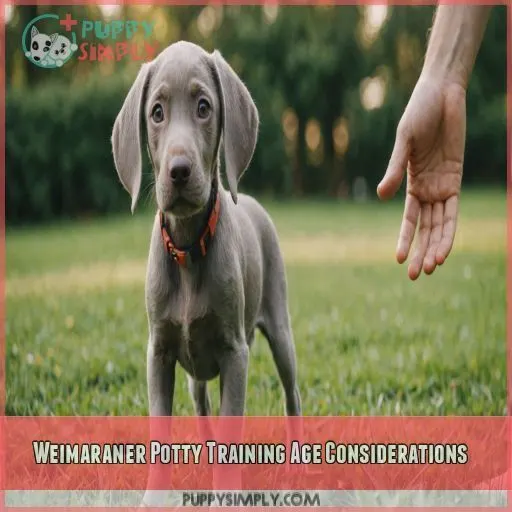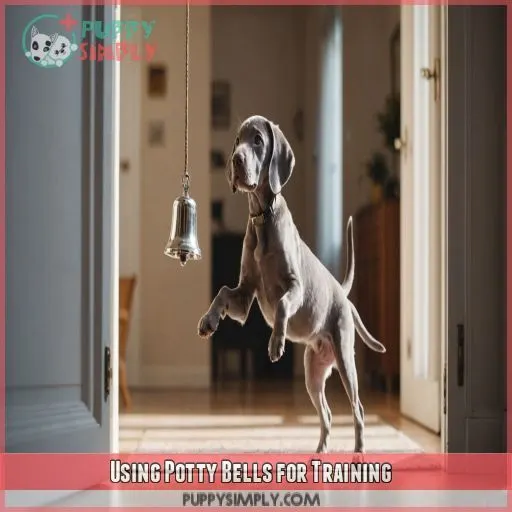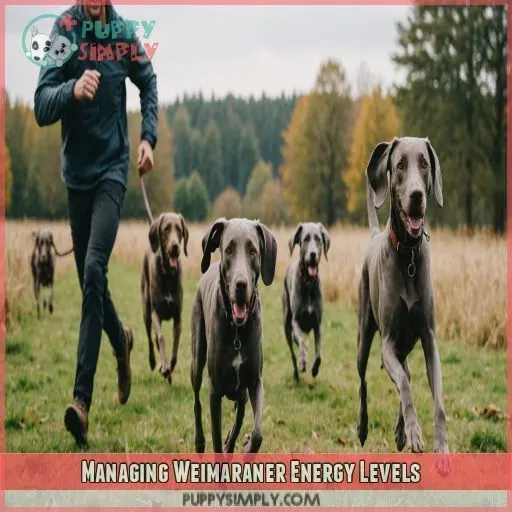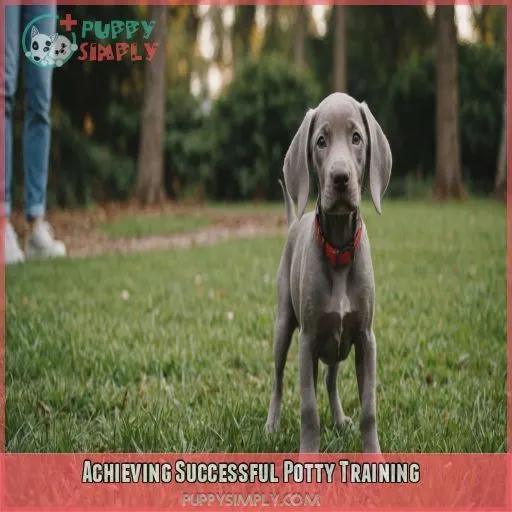This site is supported by our readers. We may earn a commission, at no cost to you, if you purchase through links.

This game-changing approach syncs your dog’s natural habits with your busy schedule.
Start by establishing a consistent routine, choosing a designated potty area, and using positive reinforcement techniques like treats and praise.
Next, create a schedule that syncs feeding times with bathroom breaks every 2-3 hours.
Watch for sniffing and circling behaviors, and reward successful potty times with treats.
By clustering these habits, you’ll be well on your way to a well-trained Weimaraner.
But, what about overcoming common potty training challenges?
Table Of Contents
- Key Takeaways
- Weimaraner Potty Training Essentials
- Creating a Potty Training Schedule
- Recognizing Potty Training Signs
- Effective Crate Training Methods
- Rewarding Good Potty Behavior
- Common Potty Training Challenges
- Weimaraner Potty Training Age Considerations
- Using Potty Bells for Training
- Managing Weimaraner Energy Levels
- Achieving Successful Potty Training
- Frequently Asked Questions (FAQs)
- Are Weimaraners hard to housebreak?
- What is the hardest dog to potty train?
- How do you potty train a hoarder dog?
- How do you potty train a Weimaraner puppy?
- How long does potty training take for Weimaraner puppies generally?
- What if my Weimaraner puppy doesnt eliminate outside immediately?
- Can Weimaraner puppies be potty trained without a yard easily?
- How do I handle Weimaraner potty training in extremely cold weather?
- What is the best way to clean up Weimaraner potty accidents indoors?
- Conclusion
Key Takeaways
- You’re in for a treat with Weimaraner cluster potty training – it’s all about synchronizing your dog’s natural habits with your busy schedule! By establishing a consistent routine, choosing a designated potty area, and using positive reinforcement techniques like treats and praise, you’ll be well on your way to a well-trained Weimaraner.
- Don’t get discouraged by accidents – they’re an inevitable part of the potty training journey! Instead, focus on rewarding good behavior, watching for signs like sniffing and circling, and adjusting your training schedule as needed to stay on track.
- Crate training can be a total game-changer for Weimaraner potty training – it helps with Establishing Good Habits, reduces separation anxiety, and prevents destructive behavior when you’re not around to supervise.
, reduces separation anxiety, and prevents destructive behavior when you’re not around to supervise. Just remember to introduce the crate gradually and avoid excessive crate time to keep your pup happy and healthy.
- You’re not alone in this wild ride of potty training – many Weimaraner owners have been in your shoes before! Stay patient, consistent, and positive, and don’t hesitate to seek professional help if you need guidance or support along the way. With time, effort, and practice, you’ll be celebrating potty training success in no time!
Weimaraner Potty Training Essentials
You’re about to begin the adventure of potty training your Weimaraner, and with the right essentials, you’ll be well on your way to raising a well-behaved and accident-free furry friend.
By mastering the fundamentals of Weimaraner potty training, you’ll set yourself up for success and make the training process a breeze.
The key fundamentals of Weimaraner potty training include choosing a designated potty area, establishing a consistent routine, and using positive reinforcement techniques.
Choosing a Designated Potty Area
Pick a designated potty area that’s easily accessible, preferably with grass or dirt, and quiet – think a peaceful park. A smaller yard is fine, but make certain your Weimaraner has enough space to sniff and circle comfortably.
Establishing a Consistent Routine
Now that you’ve chosen a designated potty area, it’s time to establish a consistent routine. Create a schedule for feeding, playtime, and potty breaks to help your Weimaraner learn when it’s time to go. Consistency is key to successful potty training.
Positive Reinforcement Techniques
Now that you’ve established a consistent routine, it’s time to focus on positive reinforcement techniques to encourage good potty behavior. Here are some effective methods:
- Rewarding Good Behavior with treats and praise
- Using Verbal Praise Techniques to boost confidence
- Showering Affection Based Rewards for successful potty breaks
Crate Training for Potty Training
If you’re thinking about potty training your Weimaraner, crate training can be a game-changer. Here’s a snapshot of how to do it right:
| Crate Size | Potty Training Tools | Benefits |
|---|---|---|
| Small (18-24") | Potty bells, treats | Reduces accidents, speeds up training |
| Medium (24-36") | Crate pads, toys | Gives your Weimaraner a sense of security |
| Large (36-48") | Training pads, clicker | Helps with housetraining, reduces separation anxiety |
Creating a Potty Training Schedule
You’re about to become a master of Weimaraner potty training schedules! To set your puppy up for success, create a routine that includes regular feeding times, playtime, and bathroom breaks – and be prepared to adjust it as needed to keep your furry friend on track.
Feeding and Bathroom Breaks
Now that you’ve got the Weimaraner potty training essentials down, it’s time to create a schedule that works for you and your furry friend. Start by syncing feeding times with bathroom breaks every 2-3 hours, and reward successful potty times with treats!
Playtime and Exercise Routine
As you establish a feeding schedule, don’t forget to prioritize playtime and exercise for your Weimaraner! Aim for at least two 30-minute play sessions and one hour-long walk per day, adjusted to your dog’s age, breed, and energy level.
Adjusting the Schedule as Needed
As you juggle playtime and exercise routines, remember that life can be unpredictable – puppy growth spurts, weather changes, or travel plans can throw off your schedule. Be prepared to adjust your potty training schedule as needed to stay on track.
- Watch for changes in your puppy’s sleep patterns and adjust the schedule accordingly.
- If you have a senior dog, consider their physical limitations and adjust the schedule to prevent exhaustion, especially for breeds like best small senior dogs.
, consider their physical limitations and adjust the schedule to prevent exhaustion.
- Don’t forget to factor in new routines, Don’t forget to factor in new routines, such as building better communication classes or changes in your work schedule.
.
Importance of Consistency
Consistency is key when creating a potty training schedule for your Weimaraner. Stick to your routine, even on weekends and holidays, to avoid confusing your pup. Set reminders, use a planner, or enlist a training buddy to help you stay on track.
Recognizing Potty Training Signs
When you start potty training your Weimaraner, recognizing the signs that your pup needs to go is key for quick results.
You’ll be able to anticipate their potty needs and get them to the designated bathroom spot in no time.
Sniffing and Circling Behaviors
You’re on high alert for those subtle potty training signals! Weimaraners often exhibit sniffing and circling behaviors when nature calls. Catch these dog communication cues to quickly swoop in and save the day (and your carpet)!
- Stay vigilant: Keep an eye on your Weimaraner’s body language.
- Circle game: If your dog starts circling, quickly take them to the designated potty area.
- Sniff sniff: If your Weimaraner starts sniffing, it’s likely they need to go potty.
- Reward success: Praise and reward your dog for eliminating outside to reinforce good behavior.
Whining and Scratching at the Door
When your Weimaraner whines and scratches at the door, it’s likely a potty emergency. Stay calm, and quickly take them to the designated potty area.
| Door-Scratching Reasons | Puppy Whining Cues |
|---|---|
| Needs to go potty | High-pitched whine |
| Separation anxiety | Whining with pacing |
| Boredom or attention-seeking | Whining with pawing |
| Medical issues | Persistent whining |
| Needs exercise or playtime | Whining with running |
Watching for Body Language Cues
As you tune into your Weimaraner’s body language, for telltale signs like tail wags, sniffing, ear position, and stance. Vocalizations can also be a dead giveaway. By decoding these cues, you’ll be better equipped to respond to their potty needs.
Anticipating Potty Needs
As you get to know your Weimaraner’s body language cues, you’ll become a pro at anticipating their potty needs. Watch for puppy signals like sniffing, circling, or staring at you – it’s their way of saying, "Hey, human, I gotta go!
Effective Crate Training Methods
You’re about to become a crate-training master, and your Weimaraner will thank you for it! By introducing the crate gradually, using it for naps and supervision, and avoiding excessive crate time, you’ll help your furry friend learn to hold it in and go potty outside where they belong.
Introducing the Crate Gradually
Introducing the crate gradually is key to successful potty training. Start by placing treats and toys inside, encouraging your Weimaraner to explore and associate the crate with positive experiences. Begin with short periods, increasing crate time as they become comfortable.
Using the Crate for Naps and Supervision
Training your Weimaraner to use a crate for naps and supervision is key. Here are four things to keep in mind:
- Place the crate in a quiet area for naps
- Supervise your puppy for 1-2 hours at a time
- Use crate training tools like treats and toys
- Make sure the crate size is just right for your puppy
Avoiding Excessive Crate Time
Now that you’re using the crate for naps and supervision, remember to avoid excessive crate time. Weimaraners need exercise and potty breaks every few hours. Balance crate time with supervised playtime to prevent boredom and keep your pup happy and healthy.
Crate Size and Comfort Considerations
When choosing a crate, consider your Weimaraner’s growth rate and ultimate size. Opt for a crate that’s comfortable, not cramped, with adequate bedding. Place it in a quiet area, and remember, a cozy crate is key to successful potty training.
Rewarding Good Potty Behavior
You’re on a roll with potty training your Weimaraner – now it’s time to focus on rewarding that good behavior! By using treats, praise, and affection, you’ll create a positive association with going potty outside and encourage your dog to keep up the good work.
Using Treats and Praise
Now that you’ve got crate training down, it’s time to reward that good potty behavior! Using treats and praise is a winning combo – think tasty bites, affectionate ear scratches, and genuine, enthusiastic "good boy!" or "good girl!" shoutouts.
Timing of Rewards for Maximum Impact
Reward your Weimaraner the instant they finish their business – it’s all about instant gratification! Delayed rewards can confuse them. Frequency matters too: reward every time at first, then gradually space them out as good habits form.
Creating a Positive Association
As a Weimaraner owner, you want to create a positive association with good potty behavior. By reinforcing good behavior, your dog will learn to associate freedom and rewards with calm, well-mannered actions. Here are four ways to achieve this:
- Timing is everything: Reward your Weimaraner immediately after they finish their business.
- Praise and affection: Use praise, affection, and treats to reinforce good behavior.
- Reward calm behavior: Positively reinforce calm behavior, reducing excitement and accidents.
- Associate freedom with rewards: Grant freedom and rewards for good potty behavior, fostering loyalty and trust.
Avoiding Punishment for Accidents
When accidents happen, don’t scold or punish your Weimaraner. Instead, calmly redirect them to the designated potty area and reward good behavior. Practice accident forgiveness and focus on positive reframing to help your dog learn from mistakes, not fear them.
Common Potty Training Challenges
You’ve made it to the not-so-glamorous part of potty training – dealing with accidents and setbacks. Don’t worry, it’s normal to encounter some bumps along the way, and with the right strategies, you can overcome common challenges like stubbornness, separation anxiety, and more.
Dealing With Accidents and Setbacks
- Clean up accidents without fuss to avoid creating negative associations.
- Identify the cause of the setback, whether it’s a medical issue or a training error.
- Adjust your training schedule as needed to prevent future accidents.
- Reward good behavior to reinforce positive habits and overcome potty regression.
Overcoming Stubbornness and Resistance
Don’t let your Weimaraner’s stubbornness get the best of you! Stay calm, patient, and consistent. Reward good behavior and redirect bad. Remember, their hunting heritage makes them prone to independent thinking – use positive reinforcement to keep them on track.
| Stubbornness Signs | Causes | Solutions |
|---|---|---|
| Refusing to go potty | Lack of consistency | Establish a routine |
| Ignoring commands | Insufficient rewards | Increase positive reinforcement |
| Pulling on the leash | Excess energy | Add more exercise and playtime |
| Sniffing instead of potty | Distractions | Minimize distractions, use redirection |
| Accidents in the house | Medical issues or lack of training | Consult a vet, increase training |
Managing Separation Anxiety
The dreaded separation anxiety! To manage this common potty training challenge, consider these tips:
- Gradual crate training: Ease your Weimaraner into alone time.
- Doggy daycare: Socialization can help reduce anxiety.
- Calming aids: Pheromone diffusers, Calming aids: Natural Calming Ingredients like pheromone diffusers, calming treats, or music can soothe.
, or music can soothe.
- Desensitization: Practice short departures to reduce distress.
Seeking Professional Help
Don’t be afraid to seek professional help if you’re struggling with potty training. A certified trainer can provide personalized guidance, addressing behavioral issues and recommending specialized programs. Compare costs and styles to find the perfect fit for you and your Weimaraner.
Weimaraner Potty Training Age Considerations
When you start potty training your Weimaraner, When you start potty training your Weimaraner, When you start potty training your Weimaraner, you need to think about their age and adjust your training techniques accordingly like you would for sleeping habits.
, just like with rare breed training.
. Whether you’re working with a rambunctious puppy or a stubborn adult dog, patience and consistency are key to successful potty training, so be prepared to adapt your approach to meet their unique needs.
Training Puppies Vs. Adult Dogs
Training a Weimaraner puppy is like playing a game of dog frisbee – unpredictable, yet fun! Puppies are more receptive to new habits, but require more frequent potty breaks. Adult dogs, on the other hand, can be more stubborn, but with patience and consistency, they can still learn new tricks.
Adjusting Training Techniques for Age
As your Weimaraner grows, so should your training approach. For puppies, it’s all about short, frequent potty breaks. For adult dogs, you can gradually increase the time between breaks. Be flexible and adjust your schedule according to your dog’s age and needs. Consistency matters, so stick to your routine and make adjustments as needed.
Importance of Patience and Consistency
When potty training your Weimaraner, patience and consistency are key. It’s normal to encounter setbacks, stubbornness, and frustration, but don’t give up! Stay committed to the process, and you’ll see progress. Here are some reminders to keep you on track:
- Potty training is a long-term commitment, not a sprint.
- Setbacks happen, but don’t define your journey.
- Consistency breeds habits, so stick to your routine.
- Your Weimaraner’s stubbornness is a normal part of the process.
- Celebrate small wins to keep you motivated and engaged.
Using Potty Bells for Training
You’re about to discover a game-changing secret in Weimaraner potty training: the power of potty bells. By teaching your dog to ring a bell when they need to go outside, you’ll reduce accidents and strengthen your bond and create a more efficient potty routine.
Introducing Potty Bells to Your Weimaraner
Now that you’ve considered your Weimaraner’s age, let’s tackle a game-changer: potty bells! Introduce them by placing the bell near the door and encouraging your pup to touch it with their nose or paw before heading out.
Teaching Your Dog to Ring the Bell
Now that you’ve introduced potty bells to your Weimaraner, it’s time to teach them to ring the bell. Start by holding a treat above the bell and encouraging your dog to nudge it with their nose or paw to ring it.
Benefits of Using Potty Bells
Using potty bells can be a game-changer for Weimaraner owners. Here are the benefits:
- Clear communication: Your dog can tell you when they need to go.
- Positive reinforcement: Reward your dog for using the bell correctly.
- Convenient potty breaks: No more guessing when your dog needs to go.
Tips for Successful Potty Bell Training
To master potty bell training, focus on timing, placement, and consistency. Here are some tips:
| Tips | Benefits |
|---|---|
| Place the bell near the door | Encourages association with going outside |
| Use the bell consistently | Creates a clear signal for potty time |
| Reward ringing with treats | Positively reinforces desired behavior |
| Train for short durations | Prevents frustration and keeps your Weimaraner engaged |
Managing Weimaraner Energy Levels
When you start potty training your Weimaraner, you need to manage their high energy levels to prevent accidents and keep them focused on learning. By providing adequate exercise and playtime, you can help your Weimaraner stay calm and receptive to training, making the potty training process much smoother and more successful.
Providing Adequate Exercise and Playtime
As you master potty bells, remember Weimaraners are bred for hunting and need regular exercise to stay happy and focused. Aim for at least 30 minutes of playtime and physical activity per day to prevent boredom and distractions during training.
Managing High Energy Levels During Training
As you tackle Weimaraner potty training, remember to manage those high energy levels! Use energy release strategies like short sprints or playtime before training sessions to burn excess energy. Keep training sessions short and sweet to maintain focus and engagement.
Adjusting Training to Accommodate Energy Levels
You’ve got a high-energy Weimaraner on your hands. To adjust training to their energy levels, try these tweaks:
- Morning Routine Adaptations: Schedule intense training sessions during morning energy surges.
- High Energy Workouts: Incorporate physically demanding activities to burn off excess energy.
- Adapting To Lulls: Ease up on training during natural energy dips to avoid frustration.
Importance of Physical and Mental Stimulation
Regularly exercising your Weimaraner is really important, but mental stimulation is just as important. Incorporate training games, stimulating toys, and mental enrichment activities to prevent boredom and keep your pup engaged, making potty training a breeze. Think of it as a brain-body workout!
Achieving Successful Potty Training
You’re on the final stretch of Weimaraner potty training – congratulations on making it this far! Now, it’s time to seal the deal by setting realistic goals, staying consistent and patient, overcoming common challenges, and ultimately celebrating your potty training success with your trusty sidekick.
Setting Realistic Goals and Expectations
Now that you’ve got your Weimaraner’s energy levels under control, it’s time to set realistic goals and expectations for potty training. Aim to achieve full training within 3-6 months, depending on your dog’s age and breed, and don’t get discouraged by accidents.
Staying Consistent and Patient
You’re in the trenches of potty training – it’s normal to feel frustrated. Stay consistent and patient by setting reminders, tracking progress, and rewarding small wins. Your Weimaraner will learn at their own pace, so breathe and trust the process.
Overcoming Common Challenges
Someone’s having a meltdown – and it’s not just your Weimaraner! Don’t worry, housebreaking setbacks, puppy distractions, and training plateaus happen. Identify the issue, adjust your approach, and stay calm. Behavioral issues or environmental factors might be the culprit.
Celebrating Potty Training Success
You made it – your Weimaraner is potty trained! Celebrate this massive milestone with:
- Tasty treats: Special goodies to mark the occasion.
- Puppy graduation day: A fun photo shoot to commemorate their achievement.
- Playtime galore: Extra playtime to revel in your shared success.
Frequently Asked Questions (FAQs)
Are Weimaraners hard to housebreak?
Facing frustrating accidents? Don’t fret! Weimaraners can be challenging to housebreak, but with consistent training, positive reinforcement, and patience, you’ll be well on your way to raising a well-behaved, potty-trained pup.
What is the hardest dog to potty train?
You’re in for a challenge! Some of the hardest dogs to potty train include Bulldogs, Pugs, and Shih Tzus, due to their small bladders and stubborn nature. Consistency, patience, and positive reinforcement are your best friends here!
How do you potty train a hoarder dog?
In the case of potty training a hoarder dog, you’ve got your work cut out for you – it’s a ‘ruff’ road ahead! Start by establishing a routine, rewarding good behavior, and gradually increasing freedom.
How do you potty train a Weimaraner puppy?
You’re bringing home a Weimaraner puppy! To potty train, establish a routine with frequent bathroom breaks, reward good behavior with treats and praise, and watch for signs like sniffing and circling to quickly take them outside.
How long does potty training take for Weimaraner puppies generally?
Get ready for a few months of accidents and triumphs! Potty training your Weimaraner puppy typically takes 4-6 months, but with consistency, patience, and positive reinforcement, you’ll be well on your way to a mess-free home.
What if my Weimaraner puppy doesnt eliminate outside immediately?
Don’t worry if your puppy doesn’t eliminate outside immediately. It’s normal for them to sniff and explore first. Be patient, and remember to reward them the moment they do go potty, to reinforce good behavior.
Can Weimaraner puppies be potty trained without a yard easily?
Did you know 77% of dog owners consider potty training a top priority? You can potty train your Weimaraner puppy without a yard by utilizing crate training, frequent walks, and designating a specific potty area, like a balcony or indoor potty pad (Source).
How do I handle Weimaraner potty training in extremely cold weather?
To handle Weimaraner potty training in extremely cold weather, choose a covered area or invest in a puppy litter box as a backup, and limit outdoor training sessions to avoid discomfort and hypothermia (Source).
What is the best way to clean up Weimaraner potty accidents indoors?
Cleaning up after your furry friend’s accidents is like putting out a small fire – swift action prevents further damage! Grab paper towels, a pet-safe cleaner, and a neutralizing spray to eliminate lingering scents that might attract repeat performances.
Conclusion
You’ve survived the wildest ride of potty training, and your Weimaraner is now a pro at doing their business outside!
With Weimaraner cluster potty training, you’ve discovered the secret to syncing your dog’s natural habits with your busy schedule.
By following these 10 pro tips, you’ve overcome common challenges and achieved lightning-fast results.
Pat yourself on the back, and remember: consistency and patience are key to successful Weimaraner cluster potty training.

